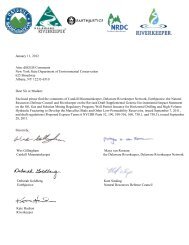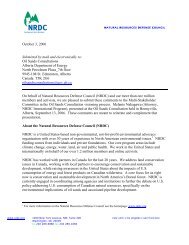3. Nuclear weapons - NRDC Document Bank - Natural Resources ...
3. Nuclear weapons - NRDC Document Bank - Natural Resources ...
3. Nuclear weapons - NRDC Document Bank - Natural Resources ...
Create successful ePaper yourself
Turn your PDF publications into a flip-book with our unique Google optimized e-Paper software.
in production; in 1984 and 1985 production was slightly below 30 per year,79<br />
with new aircraft entering both Strategic Aviation Armies and Soviet Naval<br />
Aviation regiments. The overall medium-range bomber inventory has been<br />
decreasing since Tu-16 Badgers are being retired at an accelerated rate.<br />
The range ofthe Backfire bomber is still debated, and the USA continues to<br />
estimate that the aircraft has an intercontinental capability. In October 1985, a<br />
senior US official noted that the Backfire force 'constitutes ... a strategic<br />
threat to the United States' and included the Backfire force (including those<br />
assigned to Soviet Naval Aviation) in a count of Soviet strategic nuclear<br />
forces-as did the JCS in January 1986.80Just before this pronouncement,<br />
however, it was reported that the US intelligence community revised its<br />
estimate of the Backfire's range. Previously, the DIA had estimated the<br />
unrefuelled range of the aircraft as 5000 km, more than one-third higher than<br />
the CIA estimate of 3700 km. With the revision, partly a result of a revised<br />
estimate of the aircraft's fuel consumption rate, the DIA's estimate reportedly<br />
has moved substantially towards that of the CIA.8!<br />
The tactical aircraft most often used in military exercises in the nuclear<br />
delivery role are the MiG-27 Flogger DIJ, the Su-17 Fitter C/D/H, and the<br />
Su-24 Fencer. Conversion from the Fitter to the Fencer is now complete with<br />
the Group of Soviet Forces in the GDR. Fencers are also being deployed with<br />
Strategic Aviation, probably replacing the Badgers that are being retired. The<br />
deployment of more helicopters in organic units in the Soviet Army, together<br />
with the deployment of more capable tactical SAMs (surface-to-air missiles) at<br />
division level, have led the US intelligence community to believe that<br />
close-air-support roles are increasingly being removed from new-generation<br />
tactical aircraft, which are being assigned interdiction roles.<br />
Naval developments<br />
The expansion of Soviet naval capabilities and areas of operation continued in<br />
1985. The Navy conducted three major naval exercises:<br />
1. The largest Soviet exercise ever held in the Pacific took place in April,<br />
involving some 75 per cent of the Pacific Fleet's ships and submarines. The<br />
focal point was an attack on a simulated US carrier task force designed to recreate<br />
and improve upon the Soviet response to the US Navy's 1984 fleet exercises<br />
during which Soviet aircraft flew poorly executed simulated attacks against US<br />
carriers.82<br />
2. The largest co-ordinated and most active limited-area exercise to date,<br />
Summerex 85, took place in the North Sea in July, involving 38 surface<br />
combatants, 39 attack submarines, 25 auxiliaries and hundreds of aircraft. The<br />
aircraft flew some 275 sorties, the highest number since Okean 75, and the<br />
exercise lasted twice as long as a typical exercise in the area.83<br />
<strong>3.</strong> The first amphibious landing in the Pacific since 1978 and the largest to<br />
date took place in August in the Kuril and Sakhalin Islands, involving more<br />
than 30 submarines and surface ships.84<br />
Several naval construction programmes continued in 1985. Soviet nonstrategic<br />
submarine activities, the highlight of 1984 naval developments, were<br />
less prominent during 1985. In the cruise missile-carrying category, a third
















